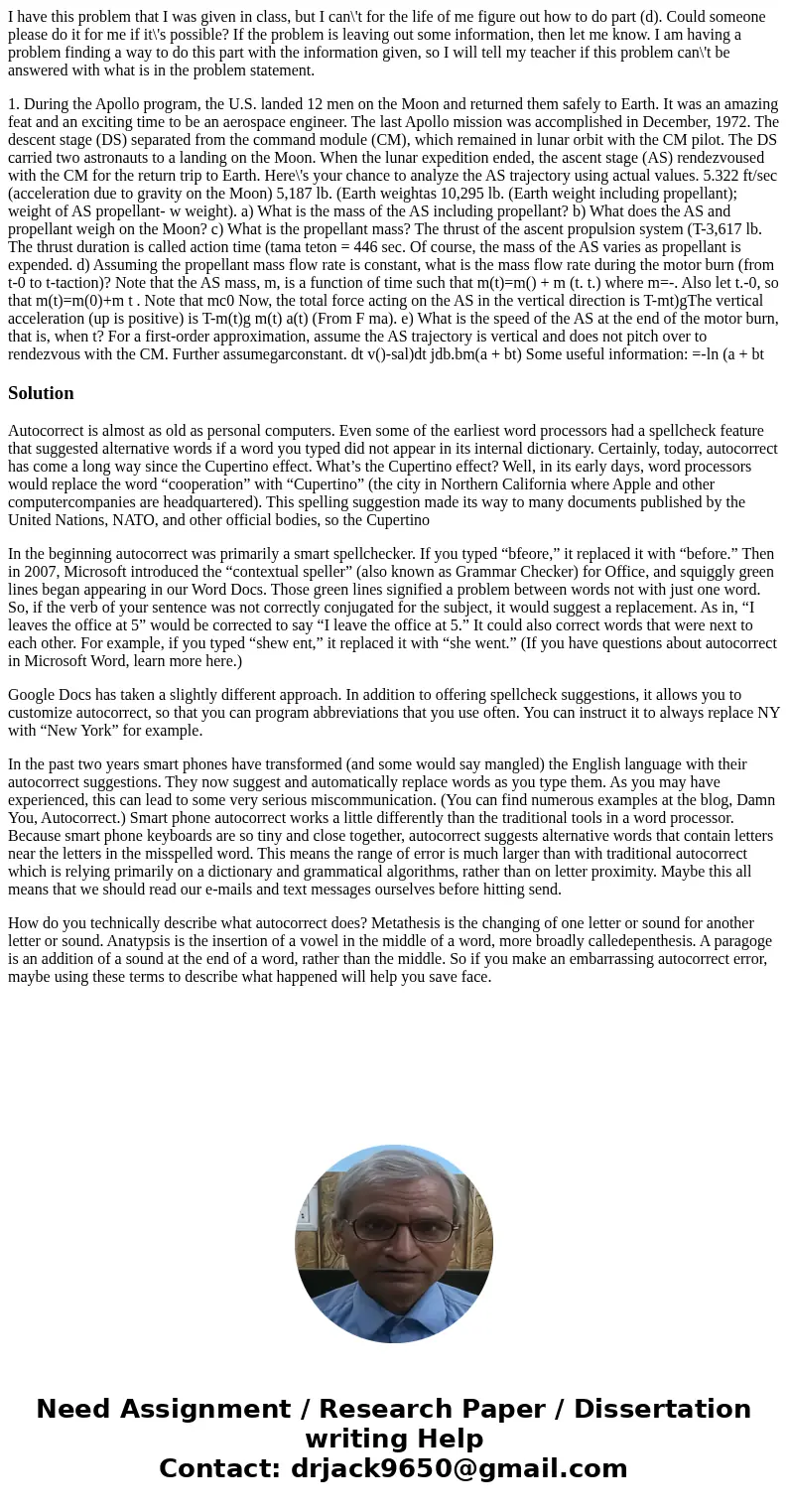I have this problem that I was given in class but I cant for
I have this problem that I was given in class, but I can\'t for the life of me figure out how to do part (d). Could someone please do it for me if it\'s possible? If the problem is leaving out some information, then let me know. I am having a problem finding a way to do this part with the information given, so I will tell my teacher if this problem can\'t be answered with what is in the problem statement.
1. During the Apollo program, the U.S. landed 12 men on the Moon and returned them safely to Earth. It was an amazing feat and an exciting time to be an aerospace engineer. The last Apollo mission was accomplished in December, 1972. The descent stage (DS) separated from the command module (CM), which remained in lunar orbit with the CM pilot. The DS carried two astronauts to a landing on the Moon. When the lunar expedition ended, the ascent stage (AS) rendezvoused with the CM for the return trip to Earth. Here\'s your chance to analyze the AS trajectory using actual values. 5.322 ft/sec (acceleration due to gravity on the Moon) 5,187 lb. (Earth weightas 10,295 lb. (Earth weight including propellant); weight of AS propellant- w weight). a) What is the mass of the AS including propellant? b) What does the AS and propellant weigh on the Moon? c) What is the propellant mass? The thrust of the ascent propulsion system (T-3,617 lb. The thrust duration is called action time (tama teton = 446 sec. Of course, the mass of the AS varies as propellant is expended. d) Assuming the propellant mass flow rate is constant, what is the mass flow rate during the motor burn (from t-0 to t-taction)? Note that the AS mass, m, is a function of time such that m(t)=m() + m (t. t.) where m=-. Also let t.-0, so that m(t)=m(0)+m t . Note that mc0 Now, the total force acting on the AS in the vertical direction is T-mt)gThe vertical acceleration (up is positive) is T-m(t)g m(t) a(t) (From F ma). e) What is the speed of the AS at the end of the motor burn, that is, when t? For a first-order approximation, assume the AS trajectory is vertical and does not pitch over to rendezvous with the CM. Further assumegarconstant. dt v()-sal)dt jdb.bm(a + bt) Some useful information: =-ln (a + btSolution
Autocorrect is almost as old as personal computers. Even some of the earliest word processors had a spellcheck feature that suggested alternative words if a word you typed did not appear in its internal dictionary. Certainly, today, autocorrect has come a long way since the Cupertino effect. What’s the Cupertino effect? Well, in its early days, word processors would replace the word “cooperation” with “Cupertino” (the city in Northern California where Apple and other computercompanies are headquartered). This spelling suggestion made its way to many documents published by the United Nations, NATO, and other official bodies, so the Cupertino
In the beginning autocorrect was primarily a smart spellchecker. If you typed “bfeore,” it replaced it with “before.” Then in 2007, Microsoft introduced the “contextual speller” (also known as Grammar Checker) for Office, and squiggly green lines began appearing in our Word Docs. Those green lines signified a problem between words not with just one word. So, if the verb of your sentence was not correctly conjugated for the subject, it would suggest a replacement. As in, “I leaves the office at 5” would be corrected to say “I leave the office at 5.” It could also correct words that were next to each other. For example, if you typed “shew ent,” it replaced it with “she went.” (If you have questions about autocorrect in Microsoft Word, learn more here.)
Google Docs has taken a slightly different approach. In addition to offering spellcheck suggestions, it allows you to customize autocorrect, so that you can program abbreviations that you use often. You can instruct it to always replace NY with “New York” for example.
In the past two years smart phones have transformed (and some would say mangled) the English language with their autocorrect suggestions. They now suggest and automatically replace words as you type them. As you may have experienced, this can lead to some very serious miscommunication. (You can find numerous examples at the blog, Damn You, Autocorrect.) Smart phone autocorrect works a little differently than the traditional tools in a word processor. Because smart phone keyboards are so tiny and close together, autocorrect suggests alternative words that contain letters near the letters in the misspelled word. This means the range of error is much larger than with traditional autocorrect which is relying primarily on a dictionary and grammatical algorithms, rather than on letter proximity. Maybe this all means that we should read our e-mails and text messages ourselves before hitting send.
How do you technically describe what autocorrect does? Metathesis is the changing of one letter or sound for another letter or sound. Anatypsis is the insertion of a vowel in the middle of a word, more broadly calledepenthesis. A paragoge is an addition of a sound at the end of a word, rather than the middle. So if you make an embarrassing autocorrect error, maybe using these terms to describe what happened will help you save face.

 Homework Sourse
Homework Sourse